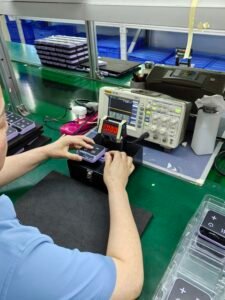If you've ever felt the soothing touch of a massage, you know its relaxing and healing benefits. But what about EMS massage? Is it different from the regular techniques you’re used to? In this article, we’ll explore the differences between regular massage and EMS massage, diving deep into how each works and what they offer for your health and wellness.
The main difference between regular massage and EMS (Electrical Muscle Stimulation) massage lies in their techniques. Regular massage uses manual pressure and movement to ease muscle tension, while EMS massage uses electrical impulses to stimulate muscles and improve circulation. Both have unique benefits, but the methods they employ are quite different.
Whether you're seeking a way to relieve stress or improve muscle recovery, understanding the differences between these two massage methods can help you choose what’s best for your needs. Let’s break down these techniques so you can make an informed decision.
What is the difference between regular massage and EMS massage?
Regular massage and EMS massage both provide benefits, but they are fundamentally different in their approach. By understanding each technique in-depth, we can compare their purposes, benefits, and the way they impact the body.
Regular massage focuses on manual techniques, like kneading and stroking, to relieve muscle tension, increase flexibility, and promote relaxation. EMS massage, on the other hand, uses electrical impulses to stimulate muscles directly, improving muscle tone, strength, and recovery.
Regular Massage: The Traditional Approach
Regular massage therapies include techniques like Swedish, deep tissue, sports, and trigger point massage. They all aim to relieve muscle tension, reduce stress, and promote relaxation through the hands-on manipulation of soft tissues. These techniques have been practiced for centuries and are rooted in different cultures.
- Swedish Massage: A gentle technique that promotes relaxation and improves circulation through long, flowing strokes.
- Deep Tissue Massage: Focuses on deeper layers of muscle and connective tissue to alleviate chronic pain and stiffness.
- Sports Massage: Tailored for athletes, this method targets specific muscles to enhance performance and recovery.
- Trigger Point Therapy: Involves applying pressure to specific "knots" or trigger points to release tension and alleviate pain.
These manual techniques are beneficial for overall wellness, stress reduction, and relaxation, making them ideal for those seeking physical and emotional relief. The hands-on nature of these massages fosters a sense of connection, often making it a deeply comforting experience.
EMS Massage: Modern Technology Meets Muscle Recovery
EMS massage is a more recent development in therapeutic treatments, and it’s often used to complement traditional massage methods or in targeted muscle rehabilitation. By using electrical impulses, EMS massage stimulates the muscles directly, mimicking the natural process of muscle contraction during exercise.
- Electrical Muscle Stimulation (EMS): EMS uses low-frequency electrical currents to stimulate muscles, causing them to contract and relax. These impulses are typically delivered through pads placed on the skin.
- Common EMS Applications: EMS is often used for pain management, muscle recovery, improving circulation, and muscle toning. It’s commonly found in physiotherapy, fitness recovery, and even in spa treatments.
Unlike traditional massages, EMS requires the use of electrical equipment, making it a more technology-driven method. EMS sessions are typically shorter but can be just as effective, especially for those recovering from injuries or looking to tone and strengthen muscles.
What are the key differences between regular massage and EMS massage?
At first glance, regular massage and EMS massage might seem to serve the same purpose: relieving muscle tension and promoting relaxation. However, there are key differences in how these techniques work and what benefits they offer.
The key difference between regular and EMS massage is the method of muscle stimulation. Regular massage uses manual pressure, whereas EMS uses electrical impulses to directly stimulate muscles, leading to different outcomes such as muscle strengthening and recovery in EMS, while regular massage mainly focuses on relaxation and stress relief.
Techniques and Methods
Regular massage is a manual therapy, where the therapist uses their hands, fingers, elbows, or even forearms to apply pressure to muscles and tissues. The massage strokes are tailored to the individual’s needs, such as focusing on areas of tension or applying gentle strokes for relaxation.
EMS massage, on the other hand, uses electrodes attached to the skin, which send electrical impulses that trigger muscle contractions. This type of massage requires specialized equipment and is typically done either in a physiotherapy clinic or spa.
Benefits
-
Regular Massage: Best known for relaxation, stress relief, and improving circulation. It also helps reduce muscle soreness and promotes general well-being. Ideal for reducing mental stress and alleviating pain caused by tension.
-
EMS Massage: Primarily used for muscle strengthening, toning, and recovery. It can help with rehabilitation by stimulating muscles that may not be engaged in traditional physical activity. EMS massage is often used for improving athletic performance and relieving chronic pain in specific muscles.
Duration of Treatment
Regular massage sessions typically last from 30 minutes to an hour, depending on the type of massage and the client’s preferences. EMS massage, however, usually takes less time, with sessions lasting between 10 to 20 minutes, as the electrical impulses work more quickly on the muscles.
Areas of Application
-
Regular Massage: Can be used to treat the entire body, with therapists targeting specific problem areas like the back, neck, shoulders, or legs.
-
EMS Massage: Focuses on specific muscle groups, making it ideal for localized muscle recovery or rehabilitation. EMS is great for targeting muscles that are difficult to work with conventional exercises.
What is Regular Massage?
Regular massage is a well-known therapy that has been practiced for centuries. It uses human hands to manipulate the muscles and soft tissues of the body. Let’s break down the definition, techniques, and benefits of this therapeutic practice.
Regular massage uses manual techniques, including kneading, rubbing, and stretching, to relieve muscle tension, improve circulation, and promote relaxation. It is widely used for general wellness, stress reduction, and muscle recovery.
Definition and General Techniques Used
Regular massage includes a variety of techniques such as Swedish, deep tissue, and sports massage. The massage therapist applies different types of pressure and movement to stimulate the muscles, improve flexibility, and release built-up tension. The techniques used can vary depending on the goal of the massage—whether it's to relax or to address chronic pain.
Benefits and Common Uses
-
Relaxation: The most common use of regular massage is to reduce stress and induce a state of calm. The rhythmic strokes help lower cortisol (stress hormone) levels, promoting a sense of peace.
-
Pain Relief: Massage can be used to relieve pain from conditions like chronic back pain, fibromyalgia, or muscle soreness after exercise. Deep tissue massage is often used for this purpose.
-
Improved Circulation: By applying pressure to muscles and tissues, massage helps improve blood flow, which can boost oxygen and nutrient delivery to tissues and support recovery.
-
Better Flexibility and Mobility: Regular massage can increase joint flexibility and muscle length, making it beneficial for people recovering from injuries or those who have limited range of motion.
What is EMS Massage?
EMS (Electrical Muscle Stimulation) massage is a more modern technique that utilizes electrical impulses to stimulate muscles. Unlike regular massage, which relies on manual techniques, EMS uses technology to help the muscles contract and relax. Let’s explore how it works.
EMS massage involves the use of electrical currents to stimulate muscle contractions, promoting muscle strength, tone, and recovery. It’s often used for rehabilitative purposes, such as helping to regain muscle function after an injury.
Definition of EMS (Electrical Muscle Stimulation)
EMS involves sending electrical impulses to the muscles through electrodes placed on the skin. These impulses mimic the natural electrical signals from the brain that cause muscles to contract. EMS is widely used in physical therapy, rehabilitation, and sports recovery.
How it Works and Common Applications
-
Pain Relief and Muscle Recovery: EMS helps reduce pain by stimulating endorphin production and encouraging the muscles to contract, which improves blood flow and speeds up recovery.
-
Muscle Strengthening: EMS is also used to tone and strengthen muscles, especially in cases where an individual is unable to engage in regular physical activity.
-
Rehabilitation: EMS is often used after surgeries or injuries to activate and strengthen muscles that have weakened due to immobility.
Key Differences Between Regular Massage and EMS Massage
Comparing regular massage to EMS massage is like comparing the traditional with the modern. Both offer unique benefits, but the methods and results vary significantly. Let’s examine the key differences.
Regular massage focuses on relaxation and tension relief using manual techniques, while EMS massage uses electrical impulses to activate muscles, focusing on recovery, strengthening, and muscle toning.
Conclusion
In summary, both regular massage and EMS massage offer unique benefits for health and wellness. Regular massage is great for relaxation, pain relief, and stress management, while EMS massage targets muscle strengthening, toning, and recovery. Understanding these differences can help you choose the right type of massage for your needs.





